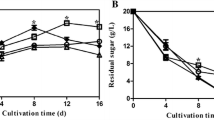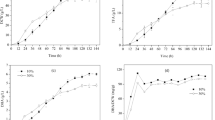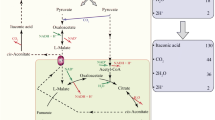Abstract
The effects of oxygen limitation on the production of ganoderic acid (GA), a secondary metabolite with antitumor activity, and on transcription levels of triterpene biosynthesis genes were investigated in liquid cultures of Ganoderma lucidum. A low oxygen supply level was beneficial to total GA biosynthesis, but negative to the cell growth. The higher GA production was obtained under micro-aerobic conditions (i.e. initial overall kLa values at 0.02 and 0.13/h). The maximum GA production of 272.3 ± 11.5 mg/L was obtained at an initial overall kLa of 0.13/h, which was 1.7-fold that at a normal cultivation condition (an initial kLa of 5.51/h). For four major individual GAs, the production level of GA-Mk, -T, -S, and -Me in the hypoxia-induced cells was increased by 50, 87, 62, and 111%, compared with that of the control, respectively. Meanwhile, the transcriptions of four key genes encoding 3-hydroxy-3-methylglutaryl coenzyme A reductase, mevalonate-5-pyrophosphate decarboxylase, squalene synthase and squalene epoxidase in the triterpene biosynthetic pathway were up-regulated under the hypoxia condition (at an initial kLa of 0.13/h). Reactive oxygen species was generated in response to hypoxia, which seemed to be involved in the regulation of GA biosynthesis. The information obtained provides an insight into the role of oxygen limitation in the GA biosynthesis, and will be helpful for optimizing the fermentation process on a large scale.
Similar content being viewed by others
References
Boh, B., M. Berovic, J. S. Zhang, and Z. B. Lin (2007) Ganoderma lucidum and its pharmaceutically active compounds. Biotechnol. Annual Rev. 13: 265–301.
Wang, J. L., T. Gu, and J. J. Zhong (2012) Enhanced recovery of antitumor ganoderic acid T from Ganoderma lucidum mycelia by novel chemical conversion strategy. Biotechnol. Bioeng. 109: 754–762.
Tang, W., J. W. Liu, W. M. Zhao, D. Z. Wei, and J. J. Zhong (2006) Ganoderic acid T from Ganoderma lucidum mycelia induces mitochondria mediated apoptosis in lung cancer cells. Life Sci. 80: 205–211.
Akihisa, T., Y. Nakamura, M. Tagata, H. Tokuda, K. Yasukawa, E. Uchiyama, T. Suzuki, and Y. Kimura (2007) Anti-inflammatory and anti-tumor-promoting effects of triterpene acids and sterols from the fungus Ganoderma lucidum. Chem. Biodivers. 4: 224–231.
Chen, N. H. and J. J. Zhong (2009) Ganoderic acid Me induces G1 arrest in wild-type p53 human tumor cells while G1/S transition arrest in p53-null cells. Proc. Biochem. 44: 928–933.
El-Mekkawy, S., M. R. Meselhy, N. Nakamura, Y. Tezuka, M. Hattori, N. Kakiuchi, K. Shimotohno, T. Kawahata, and T. Otake (1998) Anti-HIV-1 and anti-HIV-1-protease substances from Ganoderma lucidum. Phytochem. 49: 1651–1657.
Zhong, J. J. and Y. J. Tang (2004) Submerged cultivation of medicinal mushrooms for production of valuable bioactive metabolites. Adv. Biochem. Eng. Biotechnol. 87: 25–59.
Fang, Q. F. and J. J. Zhong (2002) Submerged fermentation of higher fungus Ganoderma lucidum for production of valuable bioactive metabolites-ganoderic acid and polysaccharide. Biochem. Eng. J. 10: 61–65.
Liang, C. X., Y. B. Li, J. W. Xu, J. L. Wang, X. L. Miao, Y. J. Tang, T. Y. Gu, and J. J. Zhong (2010) Enhanced biosynthetic gene expressions and production of ganoderic acids in static liquid culture of Ganoderma lucidum under phenobarbital induction. Appl. Microbiol. Biotechnol. 86: 1367–1374.
Ren, A., L. Qin, L. Shi, X. Dong, D. S. Mu, Y. X. Li, and M. W. Zhao (2010) Methyl jasmonate induces ganoderic acid biosynthesis in the basidiomycetous fungus Ganoderma lucidum. Bioresour. Technol. 101: 6785–6790.
Tang, Y. J. and L. W. Zhu (2010) Improvement of ganoderic acid and Ganoderma polysaccharide biosynthesis by Ganoderma lucidum fermentation under the inducement of Cu2+. Biotechnol. Prog. 26: 417–423.
Zhao, W., J. W. Xu, and J. J. Zhong (2011) Enhanced production of ganoderic acids in static liquid culture of Ganoderma lucidum under nitrogen-limiting conditions. Bioresour. Technol. 102: 8185–8190.
Garcia-Ochoa, F., E. Gomez, V. E. Santos, and J. C. Merchuk (2010) Oxygen uptake rate in microbial processes: An overview. Biochem. Eng. J. 49: 289–307.
Narta, U., S. Roy, S. S. Kanwar, and W. Azmi (2011) Improved production of l-asparaginase by Bacillus brevis cultivated in the presence of oxygen-vectors. Bioresour. Technol. 102: 2083–2085.
Shih, I. L., K. Pan, and C. Hsieh (2006) Influence of nutritional components and oxygen supply on the mycelial growth and bioactive metabolites production in submerged culture of Antrodia cinnamomea. Proc. Biochem. 41: 1129–1135.
Xu, Y. and J. J. Zhong (2011) Significance of oxygen supply in production of a novel antibiotic by Pseudomonas sp. SJT25. Bioresour. Technol. 102: 9167–9174.
Branco, R. F., J. C. Santos, B. F. Sarrouh, J. D. Rivaldi, A. Pessoa, and J. S. S. Silva (2009) Profiles of xylose reductase, xylitol dehydrogenase and xylitol production under different oxygen transfer volumetric coefficient values. J. Chem. Technol. Biotechnol. 84: 326–330.
Bule, M. V. and R. S. Singhal (2010) Combined effect of agitation/ aeration and fed-batch strategy on ubiquinone-10 production by Pseudomonas diminuta. Chem. Eng. Technol. 33: 885–894.
Hsieh, C. Y., M. H. Tseng, and C. J. Liu (2006) Production of polysaccharides from Ganoderma lucidum (CCRC 36041) under limitations of nutrients (CCRC 36041) under limitations of nutrients. Enz. Microb. Technol. 38: 109–117.
Zou, Y. Z., K. Qi, X. Chen, X. L. Miao, and J. J. Zhong, (2010) Favorable effect of very low initial kLa value on xylitol production from xylose by a self-isolated strain of Pichia guilliermondii. J. Biosci. Bioeng. 109: 149–152.
Blokhina, O. and K. V. Fagerstedt (2010) Oxidative metabolism, ROS and NO under oxygen deprivation. Plant Physiol. Biochem. 48: 359–373.
Tang, Y.J. and J. J. Zhong (2003) Role of oxygen supply in submerged fermentation of Ganoderma lucidum for production of Ganoderma polysaccharide and ganoderic acid. Enz. Microb. Technol. 32: 478–484.
Tang, Y. J., W. Zhang, and J. J. Zhong (2009) Performance analyses of a pH-shift and DOT-shift integrated fed-batch fermentation process for the production of ganoderic acid and Ganoderma polysaccharides by medicinal mushroom Ganoderma lucidum. Bioresour. Technol. 100: 1852–1859.
Zlokarnik, M. (1978) Sorption characteristics for gas-liquid contacting in mixing vessels. Adv. Biochem. Eng. 8: 133–151.
Dubois, M., K. A. Gilles, J. K. Hamilton, P. A. Rebers, and F. Smith (1956) Colorimetric method for determination of sugars and related substances. Anal. Chem. 28: 350–356.
Xu, J. W., Y. N. Xu, and J. J. Zhong (2010) Production of individual ganoderic acids and expression of biosynthetic genes in liquid static and shaking cultures of Ganoderma lucidum. Appl. Microbiol. Biotechnol. 85: 941–948.
Livak, K. and T. D. Schmittgen (2001) Analysis of relative gene expression data using real-time quantitative PCR and the 2−ΔΔCT method. Methods 25: 402–408.
Nakano, K., R. Katsu, K. Tada, and M. Matsumura (2000) Production of highly concentrated xylitol by Candida magnoliae under a microaerobic condition maintained by simple fuzzy control. J. Biosci. Bioeng. 89: 372–376.
Chen, N. H., J. W. Liu, and J. J. Zhong (2010) Ganoderic acid T inhibits tumor invasion in vitro and in vivo through inhibition of MMP expression. Pharmacol. Rep. 62: 150–163.
Liu, R. M. and J. J. Zhong (2012) Ganoderic acid Mf and S induce mitochondria mediated apoptosis in human cervical carcinoma HeLa cells. Phytomed. 19: 569.
Zhang, W. X. and J. J. Zhong (2010) Effect of oxygen concentration in gas phase on sporulation and individual ganoderic acids accumulation in liquid static culture of Ganoderma lucidum. J. Biosci. Bioeng. 109: 37–40.
Rathore, R., Y. M. Zheng, C. F. Niu, Q. H. Liu, A. Korde, Y. S. Ho, and Y. X. Wang (2008) Hypoxia activates NADPH oxidase to increase [ROS]i and [Ca2+]i through mitochondrial ROS-PKCɛ signaling axis in pulmonary artery smooth muscle cells. Free Radic. Biol. Med. 45: 1223–1231.
Setiadi, E.R., T. Doedt, F. Cottier, C. Noffz. and J. F. Ernst (2006) Transcriptional response of Candida albicans to hypoxia: Linkage of oxygen sensing and efg1p-regulatory networks. J. Mol. Biol. 361: 399–411.
Morard, P., J. Silvestre, L. Lacoste, E. Caumes, and T. Lamaze (2004) Nitrate uptake and nitrite release by tomato roots in response to anoxia. J. Plant Physiol. 161: 855–865.
Yeh, S. F., C. S. Chou, L. J. Lin, and M. S. Shiao (1989) Biosynthesis of oxygenated triterpenoids in Ganoderma lucidum. Proc. Natl. Sci. Council B. ROC. 13: 119–127.
Hirotani, M., I. Asaka, and T. Furuya (1990) Investigation of the biosynthesis of 3-hydroxy triterpenoids, ganoderic acids T and S by application of a feeding experiment using [1, 2-13C2] acetate. J. Chem. Soc. Perkin. Trans. 1: 2751–2754.
Shang, C. H., F. Zhu, N. Li, X. Yang, L. Shi, M. W. Zhao, and Y. X. Li (2008) Cloning and characterization of a gene encoding HMG-CoA reductase from Ganoderma lucidum and its functional identification in yeast. Biosci. Biotechnol. Biochem. 72: 1333–1339.
Lee, J. H., Y. H. Yoon, H. Y. Kim, D. H. Shin, D. U. Kim, I. J. Lee, and K. U. Kim (2002) Cloning and expression of squalene synthase cDNA from hot pepper (Capsicum annuum L.). Mol. Cells 13: 436–443.
Shiao, M. S. (1992) Triterpenoid natural products in the fungus Ganoderma lucidum. J Chin. Chem. Soc. 39: 669–674.
Zhang, W. X., Y. J. Tang, and J. J. Zhong, (2010) Impact of oxygen level in gaseous phase on gene transcription and ganoderic acid biosynthesis in liquid static cultures of Ganoderma lucidum. Bioproc. Biosyst. Eng. 33: 683–690.
Author information
Authors and Affiliations
Corresponding author
Rights and permissions
About this article
Cite this article
Zhang, WX., Zhong, JJ. Oxygen limitation improves ganoderic acid biosynthesis in submerged cultivation of Ganoderma lucidum . Biotechnol Bioproc E 18, 972–980 (2013). https://doi.org/10.1007/s12257-013-0148-0
Received:
Revised:
Accepted:
Published:
Issue Date:
DOI: https://doi.org/10.1007/s12257-013-0148-0




